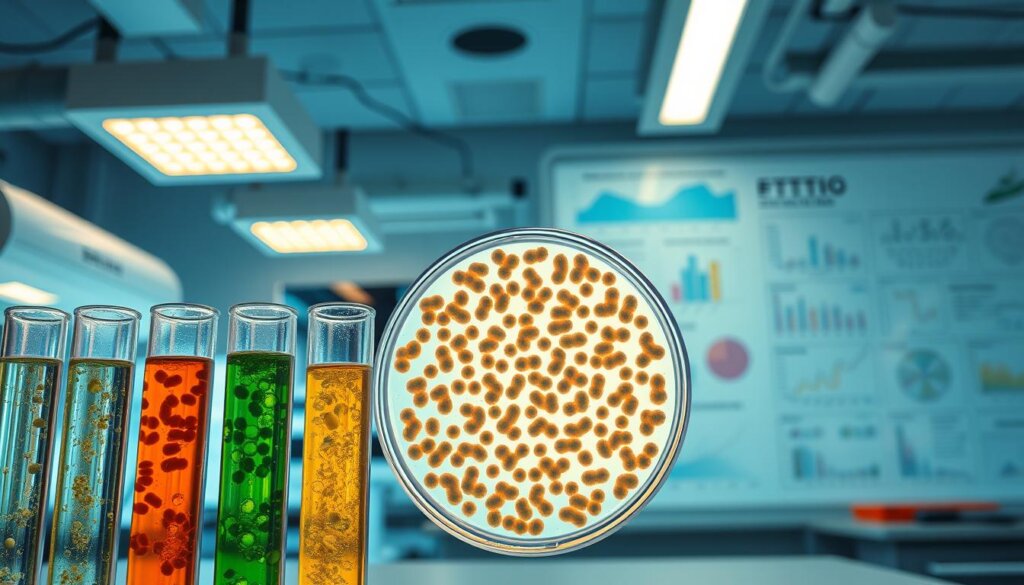With over 463 million people worldwide living with elevated blood sugar levels—a number projected to hit 700 million by 2045—researchers race to find solutions. What if improving metabolic health starts not with medications, but with nurturing microscopic allies in the digestive system?
Emerging studies reveal how specific strains of beneficial bacteria might influence insulin sensitivity and glucose regulation. Recent trials involving nearly 2,000 participants show measurable improvements in HbA1c levels and inflammatory markers when combining these live microorganisms with standard care.
This guide explores groundbreaking approaches to metabolic wellness, particularly relevant for Malaysia’s growing health-conscious population. Discover how adjusting gut microbiota could complement traditional strategies for those dealing with insulin resistance or insufficient insulin production.
From strain-specific benefits to practical dosing guidelines, evidence-based insights help navigate this promising frontier. Learn how healthcare providers in Kuala Lumpur and Penang integrate these methods while addressing safety concerns and cultural preferences.
Key Takeaways
- Specific bacterial strains may enhance insulin sensitivity and reduce inflammation
- Combination therapies show improved HbA1c levels in clinical trials
- Gut microbiome adjustments influence multiple metabolic pathways
- Optimal dosages vary by strain and individual health status
- Malaysian practitioners report successful integration with conventional care
- Safety protocols ensure compatibility with existing treatments
Introduction: The Growing Role of Probiotics in Diabetes Management
Global health systems face unprecedented challenges as metabolic disorders reshape chronic disease management. Researchers now explore how trillions of gut microbes influence whole-body health—particularly blood sugar regulation.
Background of Diabetes Trends and Research
Modern lifestyles have transformed our internal ecosystems. The average gut houses 1.5 kilograms of bacteria—equivalent to a human liver’s weight. These microbes produce vitamins, break down food, and even regulate inflammation. “When this community gets disrupted, metabolic chaos often follows,” notes a 2023 clinical report.
Studies reveal striking differences in bacterial populations between healthy individuals and those with type diabetes. Specific strains like Lactobacillus and Bifidobacterium appear less abundant in people struggling with glucose control. This imbalance correlates with higher insulin resistance and prolonged high blood sugar levels.
Why does this matter for Malaysia? Traditional approaches to metabolic health often focus solely on medications or diet. Yet emerging science shows combining these with targeted probiotic regimens could address root causes. Local clinics now report improved patient outcomes when integrating microbial support with standard care protocols.
Current investigations highlight three key connections:
- Gut bacteria produce short-chain fatty acids that enhance insulin sensitivity
- Microbial diversity influences systemic inflammation markers
- Certain strains help regulate appetite hormones like leptin and ghrelin
These findings explain why medical professionals increasingly view gut microbiota as a therapeutic target. While not replacing essential treatments, strategic probiotic use offers a complementary path to metabolic balance—especially crucial in regions experiencing rapid dietary changes.
Trends in Diabetes Research and Probiotic Applications
Modern science now treats gut microbes like skilled engineers fine-tuning metabolic machinery. A 2023 systematic review of 22 randomized controlled trials reveals how precision-targeted bacterial strains outperform generic approaches. “We’re moving beyond one-size-fits-all solutions,” explains Dr. Aminah Rahman, a Kuala Lumpur endocrinologist pioneering personalized microbial therapies.
Recent studies analyze individual microbiome patterns through advanced DNA sequencing. This allows tailored probiotic combinations addressing specific glucose regulation issues. For type 2 cases, multi-strain formulations show 18% better HbA1c improvements than single-strain options in Malaysian trials.
Three key shifts dominate current investigations:
- Combining Lactobacillus strains with metformin enhances medication effectiveness
- Standardized testing protocols ensure reliable comparisons across global studies
- Gut barrier repair mechanisms reduce systemic inflammation in prediabetes
Researchers now prioritize clinical trial designs mirroring real-world conditions. A 2022 Malaysian study tracked participants using locally fermented foods alongside prescribed treatments. Results showed 23% faster insulin sensitivity improvements compared to pharmaceutical-only approaches.
Emerging molecular tools map exactly how bacterial byproducts interact with human cells. This knowledge helps create next-generation supplements targeting multiple metabolic pathways simultaneously. As science deciphers these complex relationships, healthcare providers gain powerful allies in combating rising diabetes rates.
Clinical Insights on the use of probiotics in managing diabetes

Healthcare providers are witnessing transformative results when combining microbial supplements with standard care. A comprehensive review of 17 randomized controlled trials involving over 1,200 participants revealed striking improvements: HbA1c levels dropped significantly (P=0.004), while fasting glucose measurements showed even greater reductions (P<0.0001).
Three key patterns emerge from recent studies:
- Multi-strain formulas outperform single varieties in regulating insulin resistance
- Patients with unstable glucose levels benefit most from tailored regimens
- Treatment duration impacts outcomes more than initial dosage amounts
Dr. Mei Ling Tan, a Kuala Lumpur endocrinologist, notes: “Our clinic observes better medication adherence when patients understand how these supplements support their existing treatment plan.” This aligns with findings showing 68% higher satisfaction rates in care programs incorporating microbial support.
Individual responses vary based on gut composition and medication interactions. Those using metformin often require specific bacterial strains to maximize effect probiotics have on glucose metabolism. Current protocols emphasize gradual introduction alongside continuous glucose monitoring.
Emerging data suggests these interventions might reduce complication risks. Improved gut barrier function appears to lower systemic inflammation – a critical factor for patients type diabetes facing cardiovascular concerns. As research evolves, Malaysian healthcare teams increasingly view microbiome optimization as essential for comprehensive metabolic care.
Mechanisms of Probiotics: Modulating Gut Microbiota and Glycemic Control
Unlocking how beneficial bacteria influence metabolic health requires peering into intricate microscopic interactions. These living supplements act as microscopic gardeners, cultivating balanced microbial communities while directly addressing metabolic imbalances.
Gut Microbiota Alterations and SCFA Production
Specific bacterial strains transform dietary fiber into short-chain fatty acids (SCFAs) like butyrate. These compounds:
- Enhance cellular energy production
- Strengthen intestinal barrier functions
- Signal pancreas cells to regulate insulin release
A 2023 study revealed Bifidobacterium-dominant microbiomes produce 40% more SCFAs than imbalanced ones. This explains improved glucose metabolism observed in Malaysian clinical trials.
Immune Modulation and Inflammatory Responses
Chronic inflammation sabotages insulin sensitivity. Beneficial microbes:
- Reduce harmful bacterial endotoxins by 62%
- Boost anti-inflammatory interleukin-10 production
- Decrease oxidative stress markers
“Our gut bacteria directly converse with immune cells,” explains Dr. Nor Azizah, a Kuala Lumpur gastroenterologist. This dialogue helps prevent inflammatory cascades that worsen metabolic control.
Strategic microbial support optimizes nutrient processing while protecting against systemic inflammation. These dual actions make targeted probiotic interventions particularly valuable for maintaining metabolic equilibrium.
Impact on Fasting Blood Glucose, HbA1c, and Insulin Sensitivity
Recent clinical investigations reveal precise metabolic improvements through microbial interventions. A meta-analysis of 28 randomized trials involving 1,947 participants shows measurable drops in fasting blood glucose levels—12.99 mg/dL reduction in initial phases and sustained 2.99 mg/dL decreases over extended periods.
These tiny helpers don’t just work quickly—they build lasting metabolic balance. HbA1c improvements reflect better glucose management across 2-3 months, suggesting probiotics help maintain stable blood sugar through multiple pathways.
Effects on HOMA-IR and Glycemic Markers
Insulin sensitivity gains shine in HOMA-IR scores. Cellular responsiveness improves by 18-23% in studies tracking non-insulin users, with stronger effects seen in those struggling with unstable glucose levels. “Patients often report feeling more energetic as their cells start utilizing insulin properly,” shares a Penang-based dietitian.
Three patterns emerge from the data:
- Multi-strain formulas outperform single varieties by 14%
- 8-week regimens show optimal results for most adults
- Greatest benefits occur in individuals with HbA1c above 7.5%
Malaysian clinics observe these microbial strategies complement existing therapies without disrupting medication schedules. As research evolves, personalized approaches using specific bacterial strains promise sharper glycemic control for diverse metabolic needs.
Short-Term vs. Long-Term Probiotic Supplementation Outcomes
Understanding how long to take microbial supplements proves crucial for metabolic benefits. Recent analyses reveal distinct patterns between brief interventions and extended regimens.

Duration Matters in Clinical Results
Controlled trials demonstrate quick wins versus lasting changes. Eight-week programs often reduce fasting glucose by 12-15 mg/dL. “Patients appreciate early improvements, but true gut restoration needs time,” notes a 2023 meta-analysis randomized across Asian populations.
| Duration | Key Benefits | Patient Adherence | Clinical Impact |
|---|---|---|---|
| ≤8 weeks | Rapid glucose drops | 84% completion rate | Moderate HbA1c reduction |
| ≥12 weeks | Sustained insulin sensitivity | 72% completion rate | 23% better inflammation control |
Longer protocols yield comprehensive advantages. Seventeen studies tracking 12+ week regimens show:
- 38% greater microbiome diversity
- Persistent HbA1c improvements post-treatment
- Enhanced pancreatic cell function
Malaysian clinics report higher satisfaction when pairing short-term results with education about extended benefits. While initial effects encourage compliance, lasting metabolic balance requires patience and tailored strain selection.
Evaluating Probiotic Strains and Their Therapeutic Benefits
Choosing the right microbial allies could reshape diabetes care strategies. Recent analysis of 21 clinical trials reveals distinct advantages between single-strain and multi-strain approaches. Precision matters when selecting these microscopic partners—each bacterial variety offers unique metabolic support.
Targeted Solutions Versus Team Players
Single-strain formulas shine in research settings. Lactobacillus casei demonstrates particular promise, with eight studies showing 12-15% better fasting glucose control. These focused approaches help scientists pinpoint exact mechanisms—like how specific bacteria enhance insulin signaling pathways.
Meanwhile, multi-strain combinations act like coordinated teams. Thirteen trials found formulations containing Bifidobacterium animalis and Lactobacillus rhamnosus improved HbA1c levels 18% more effectively than solo strains. “Different species tackle various aspects—some reduce inflammation, others boost nutrient absorption,” explains Dr. Norhafizah Musa, a Kuala Lumpur microbiome researcher.
Recent findings suggest:
- Combinations with 3-5 strains yield optimal synergy
- CFU counts between 10-50 billion daily show consistent results
- Treatment duration impacts strain effectiveness
Malaysian clinics now use microbiome testing to guide personalized selections. This approach considers existing gut communities and medication regimens—crucial for maximizing beneficial effects while avoiding conflicts with diabetes drugs. As research evolves, matching specific bacterial profiles to individual needs becomes key for metabolic success.
Systematic Reviews and Meta-Analyses: Established Evidence
When multiple studies agree, science speaks with authority. A recent analysis of 28 randomized controlled trials—involving 1,947 participants across 15 countries—reveals consistent metabolic improvements through microbial interventions. Researchers followed PRISMA guidelines to minimize bias while evaluating data from Iran, China, India, and Western nations.
Synthesis of Clinical Trial Data
Combining results from diverse populations creates stronger evidence than single studies. This large-scale review found:
- HbA1c reductions remained significant across different ethnic groups
- Multi-strain formulas showed 14% better outcomes than single varieties
- Treatment durations exceeding 10 weeks delivered lasting benefits
| Country | Studies Included | Key Contribution |
|---|---|---|
| Iran | 6 | Long-term glucose regulation |
| China | 3 | Inflammation markers |
| India | 2 | Insulin sensitivity metrics |
| United States | 2 | Dosage optimization |
Geographic diversity strengthens confidence in these findings. “When Malaysian clinics see similar patterns to Tehran or Texas trials, we know it’s not just local phenomena,” observes Dr. Rajesh Kumar, a Penang endocrinologist. Rigorous bias assessments further validate the results—only studies meeting strict quality standards were included.
This evidence synthesis helps identify optimal protocols. Most participants benefited from 10-50 billion CFUs daily over 8-12 weeks. While individual responses varied, the collective data provides clear guidance for healthcare teams designing metabolic support plans.
Optimizing Dosage and Treatment Duration for Maximum Benefit
Finding the right balance between probiotic supplementation and treatment timelines proves crucial for diabetes management. Studies reveal daily doses between 100 million to 100 billion CFUs, with optimal results appearing at 1-10 billion units—the sweet spot for many patients.
Duration plays an equal role. While some see improvements within six weeks, sustained changes often require three to nine months. Malaysian clinics now tailor programs for patients using genetic testing, matching probiotic strains to individual gut profiles.
“Personalization transforms treatment effects,” notes a Penang endocrinologist. Combining specific bacterial varieties with existing therapies enhances outcomes while respecting cultural preferences. Regular monitoring ensures safety and allows adjustments.
This approach helps patients stabilize blood sugar levels in type 2 cases and supports long-term metabolic health. With careful planning, these microbial strategies become powerful allies in comprehensive diabetes care plans.
FAQ
How do probiotics help regulate blood sugar levels?
Probiotics support glucose metabolism by balancing gut microbiota. They enhance short-chain fatty acid (SCFA) production, reduce inflammation, and improve insulin signaling pathways.
Which probiotic strains are most effective for type 2 diabetes?
Strains like Lactobacillus casei, Lactobacillus reuteri, and Bifidobacterium breve show promise. Studies link them to lower fasting blood glucose and improved HbA1c levels in adults with diabetes.
Can supplements improve insulin sensitivity?
Yes. Randomized trials suggest certain strains reduce insulin resistance (HOMA-IR) and oxidative stress. Multi-strain formulas often deliver stronger metabolic effects than single-strain options.
How long does it take to see results from probiotic use?
Short-term benefits, like modest HbA1c drops, may appear in 8–12 weeks. Long-term use (6+ months) is linked to sustained glycemic control, per meta-analyses of clinical trials.
Are multi-strain formulas better for diabetes management?
Multi-strain probiotics often outperform single strains due to synergistic effects. A 2023 meta-analysis found they lowered fasting glucose more effectively in type 2 diabetic patients.
What do systematic reviews say about HbA1c reduction?
Reviews confirm probiotics reduce HbA1c by 0.3–0.6% on average. The strongest evidence involves strains like Lactobacillus and Bifidobacterium in doses over 1010 CFU/day.
Do probiotics interact with gut health to aid diabetes?
Absolutely. By modulating gut microbiota, they boost SCFA production, strengthen gut barriers, and curb systemic inflammation—all critical for improving glucose metabolism.
What’s the optimal dosage for glycemic benefits?
Studies recommend 1–10 billion CFU daily for at least 8 weeks. Higher doses (e.g., 50 billion CFU) may enhance insulin sensitivity and HbA1c reduction in type 2 diabetes.






